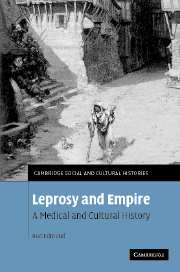Book contents
- Frontmatter
- Contents
- List of illustrations
- Acknowledgements
- Introduction
- 1 Describing, imagining and defining leprosy, 1770–1867
- 2 Scientists discuss the causes of leprosy, and the disease becomes a public issue in Britain and its empire, 1867–1898
- 3 The fear of degeneration: leprosy in the tropics and the metropolis at the fin de siècle
- 4 Segregation in the high imperial era: island leper colonies on Hawaii, at the Cape, in Australia and New Zealand
- 5 Concentrating and isolating racialised others, the diseased and the deviant: the idea of the colony in the later nineteenth and early twentieth centuries
- 6 Writers visiting leper colonies: Charles Warren Stoddard, Robert Louis Stevenson, Jack London, Graham Greene and Paul Theroux
- Postscript
- Index
3 - The fear of degeneration: leprosy in the tropics and the metropolis at the fin de siècle
Published online by Cambridge University Press: 17 July 2009
- Frontmatter
- Contents
- List of illustrations
- Acknowledgements
- Introduction
- 1 Describing, imagining and defining leprosy, 1770–1867
- 2 Scientists discuss the causes of leprosy, and the disease becomes a public issue in Britain and its empire, 1867–1898
- 3 The fear of degeneration: leprosy in the tropics and the metropolis at the fin de siècle
- 4 Segregation in the high imperial era: island leper colonies on Hawaii, at the Cape, in Australia and New Zealand
- 5 Concentrating and isolating racialised others, the diseased and the deviant: the idea of the colony in the later nineteenth and early twentieth centuries
- 6 Writers visiting leper colonies: Charles Warren Stoddard, Robert Louis Stevenson, Jack London, Graham Greene and Paul Theroux
- Postscript
- Index
Summary
The tropics and disease
Tropical medicine was a late nineteenth-century construction. Before this, medical geography provided the dominant model of explanation, and doctors examined and treated ‘diseases in the tropics’ rather than practising ‘tropical medicine’. Very few diseases were regarded as specific and most were explained in terms of the effects of climatic extremes on the ill-adapted constitutions of European bodies. The main concern of medicine in the tropics was with Europeans although, as we have seen, the health of native subjects became increasingly entangled with this. At the same time, declining mortality levels in Europe and North America highlighted the far worse disease and mortality levels in tropical regions. In fact this contrast applied more to indigenes than Europeans, whose mortality rates in the tropics were actually declining in the later nineteenth century, but pessimism about the ability of the white races to settle in equatorial regions nevertheless intensified. So too did the distinction between tropical and temperate zones.
Although the distinctiveness of the tropical environment and its maladies was a commonplace in the eighteenth century, there was optimism about the ability of Europeans to acclimatise through residence, a process referred to as ‘seasoning’. From the early nineteenth century, however, climatic theories of racial difference began to be reinforced by more essentialising biological ones. Mark Harrison cites James Thomson's A Treatise on the Diseases of the Negro as they occur in the Island of Jamaica (1820) as a significant marker of this shift, whose corollary was an increasing pessimism about the chances of European acclimatisation.
- Type
- Chapter
- Information
- Leprosy and EmpireA Medical and Cultural History, pp. 110 - 142Publisher: Cambridge University PressPrint publication year: 2006

